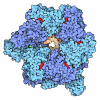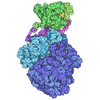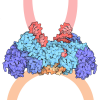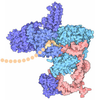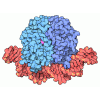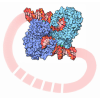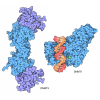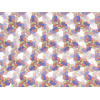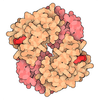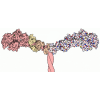+ Open data
Open data
- Basic information
Basic information
| Entry | Database: PDB / ID: 6v92 | |||||||||
|---|---|---|---|---|---|---|---|---|---|---|
| Title | RSC-NCP | |||||||||
 Components Components |
| |||||||||
 Keywords Keywords | GENE REGULATION/DNA / Chromatin remodeler / RSC / GENE REGULATION / GENE REGULATION-DNA complex | |||||||||
| Function / homology |  Function and homology information Function and homology informationregulation of sporulation resulting in formation of a cellular spore / RHO GTPases activate IQGAPs / RHO GTPases Activate WASPs and WAVEs / Regulation of actin dynamics for phagocytic cup formation / : / regulation of nuclear cell cycle DNA replication / plasmid maintenance / Platelet degranulation / DNA translocase activity / nucleosome array spacer activity ...regulation of sporulation resulting in formation of a cellular spore / RHO GTPases activate IQGAPs / RHO GTPases Activate WASPs and WAVEs / Regulation of actin dynamics for phagocytic cup formation / : / regulation of nuclear cell cycle DNA replication / plasmid maintenance / Platelet degranulation / DNA translocase activity / nucleosome array spacer activity / RSC-type complex / ATP-dependent chromatin remodeler activity / UV-damage excision repair / nucleosome disassembly / SWI/SNF complex / sister chromatid cohesion / sporulation resulting in formation of a cellular spore / nuclear chromosome / NuA4 histone acetyltransferase complex / rRNA transcription / histone H4 reader activity / chromosome, centromeric region / negative regulation of megakaryocyte differentiation / protein localization to CENP-A containing chromatin / nucleosome binding / Chromatin modifying enzymes / Replacement of protamines by nucleosomes in the male pronucleus / CENP-A containing nucleosome / : / Packaging Of Telomere Ends / Recognition and association of DNA glycosylase with site containing an affected purine / Cleavage of the damaged purine / cytoskeleton organization / Deposition of new CENPA-containing nucleosomes at the centromere / Recognition and association of DNA glycosylase with site containing an affected pyrimidine / Cleavage of the damaged pyrimidine / telomere organization / Interleukin-7 signaling / Inhibition of DNA recombination at telomere / RNA Polymerase I Promoter Opening / Meiotic synapsis / Assembly of the ORC complex at the origin of replication / SUMOylation of chromatin organization proteins / Regulation of endogenous retroelements by the Human Silencing Hub (HUSH) complex / epigenetic regulation of gene expression / DNA methylation / Condensation of Prophase Chromosomes / Chromatin modifications during the maternal to zygotic transition (MZT) / SIRT1 negatively regulates rRNA expression / HCMV Late Events / innate immune response in mucosa / ERCC6 (CSB) and EHMT2 (G9a) positively regulate rRNA expression / PRC2 methylates histones and DNA / Regulation of endogenous retroelements by KRAB-ZFP proteins / Defective pyroptosis / transcription coregulator activity / meiotic cell cycle / chromosome segregation / HDACs deacetylate histones / Regulation of endogenous retroelements by Piwi-interacting RNAs (piRNAs) / transcription elongation by RNA polymerase II / Nonhomologous End-Joining (NHEJ) / RNA Polymerase I Promoter Escape / positive regulation of transcription elongation by RNA polymerase II / Transcriptional regulation by small RNAs / Formation of the beta-catenin:TCF transactivating complex / helicase activity / double-strand break repair via homologous recombination / Activated PKN1 stimulates transcription of AR (androgen receptor) regulated genes KLK2 and KLK3 / RUNX1 regulates genes involved in megakaryocyte differentiation and platelet function / HDMs demethylate histones / base-excision repair / G2/M DNA damage checkpoint / NoRC negatively regulates rRNA expression / chromatin DNA binding / double-strand break repair via nonhomologous end joining / DNA Damage/Telomere Stress Induced Senescence / B-WICH complex positively regulates rRNA expression / PKMTs methylate histone lysines / Meiotic recombination / Pre-NOTCH Transcription and Translation / G2/M transition of mitotic cell cycle / Metalloprotease DUBs / RMTs methylate histone arginines / Activation of anterior HOX genes in hindbrain development during early embryogenesis / Transcriptional regulation of granulopoiesis / HCMV Early Events / antimicrobial humoral immune response mediated by antimicrobial peptide / structural constituent of chromatin / UCH proteinases / antibacterial humoral response / nucleosome / heterochromatin formation / double-strand break repair / nucleosome assembly / E3 ubiquitin ligases ubiquitinate target proteins / Recruitment and ATM-mediated phosphorylation of repair and signaling proteins at DNA double strand breaks / HATs acetylate histones / RUNX1 regulates transcription of genes involved in differentiation of HSCs / Factors involved in megakaryocyte development and platelet production Similarity search - Function | |||||||||
| Biological species |  Homo sapiens (human) Homo sapiens (human) synthetic construct (others) | |||||||||
| Method | ELECTRON MICROSCOPY / single particle reconstruction / cryo EM / Resolution: 20 Å | |||||||||
 Authors Authors | Patel, A.B. / Moore, C.M. / Greber, B.J. / Nogales, E. | |||||||||
| Funding support |  United States, 2items United States, 2items
| |||||||||
 Citation Citation |  Journal: Elife / Year: 2019 Journal: Elife / Year: 2019Title: Architecture of the chromatin remodeler RSC and insights into its nucleosome engagement. Authors: Avinash B Patel / Camille M Moore / Basil J Greber / Jie Luo / Stefan A Zukin / Jeff Ranish / Eva Nogales /  Abstract: Eukaryotic DNA is packaged into nucleosome arrays, which are repositioned by chromatin remodeling complexes to control DNA accessibility. The RSC (emodeling the tructure of hromatin) complex, a ...Eukaryotic DNA is packaged into nucleosome arrays, which are repositioned by chromatin remodeling complexes to control DNA accessibility. The RSC (emodeling the tructure of hromatin) complex, a member of the SWI/SNF chromatin remodeler family, plays critical roles in genome maintenance, transcription, and DNA repair. Here, we report cryo-electron microscopy (cryo-EM) and crosslinking mass spectrometry (CLMS) studies of yeast RSC complex and show that RSC is composed of a rigid tripartite core and two flexible lobes. The core structure is scaffolded by an asymmetric Rsc8 dimer and built with the evolutionarily conserved subunits Sfh1, Rsc6, Rsc9 and Sth1. The flexible ATPase lobe, composed of helicase subunit Sth1, Arp7, Arp9 and Rtt102, is anchored to this core by the N-terminus of Sth1. Our cryo-EM analysis of RSC bound to a nucleosome core particle shows that in addition to the expected nucleosome-Sth1 interactions, RSC engages histones and nucleosomal DNA through one arm of the core structure, composed of the Rsc8 SWIRM domains, Sfh1 and Npl6. Our findings provide structural insights into the conserved assembly process for all members of the SWI/SNF family of remodelers, and illustrate how RSC selects, engages, and remodels nucleosomes. | |||||||||
| History |
|
- Structure visualization
Structure visualization
| Movie |
 Movie viewer Movie viewer |
|---|---|
| Structure viewer | Molecule:  Molmil Molmil Jmol/JSmol Jmol/JSmol |
- Downloads & links
Downloads & links
- Download
Download
| PDBx/mmCIF format |  6v92.cif.gz 6v92.cif.gz | 1.1 MB | Display |  PDBx/mmCIF format PDBx/mmCIF format |
|---|---|---|---|---|
| PDB format |  pdb6v92.ent.gz pdb6v92.ent.gz | 872.5 KB | Display |  PDB format PDB format |
| PDBx/mmJSON format |  6v92.json.gz 6v92.json.gz | Tree view |  PDBx/mmJSON format PDBx/mmJSON format | |
| Others |  Other downloads Other downloads |
-Validation report
| Summary document |  6v92_validation.pdf.gz 6v92_validation.pdf.gz | 1 MB | Display |  wwPDB validaton report wwPDB validaton report |
|---|---|---|---|---|
| Full document |  6v92_full_validation.pdf.gz 6v92_full_validation.pdf.gz | 1.1 MB | Display | |
| Data in XML |  6v92_validation.xml.gz 6v92_validation.xml.gz | 117.3 KB | Display | |
| Data in CIF |  6v92_validation.cif.gz 6v92_validation.cif.gz | 191.4 KB | Display | |
| Arichive directory |  https://data.pdbj.org/pub/pdb/validation_reports/v9/6v92 https://data.pdbj.org/pub/pdb/validation_reports/v9/6v92 ftp://data.pdbj.org/pub/pdb/validation_reports/v9/6v92 ftp://data.pdbj.org/pub/pdb/validation_reports/v9/6v92 | HTTPS FTP |
-Related structure data
| Related structure data |  21114MC  6v8oC M: map data used to model this data C: citing same article ( |
|---|---|
| Similar structure data |
- Links
Links
- Assembly
Assembly
| Deposited unit | 
|
|---|---|
| 1 |
|
- Components
Components
-Protein , 9 types, 13 molecules ARBPCaebfcgdh
| #1: Protein | Mass: 53863.016 Da / Num. of mol.: 1 / Source method: isolated from a natural source Source: (natural)  Strain: ATCC 204508 / S288c / References: UniProt: Q12406 | ||||||
|---|---|---|---|---|---|---|---|
| #2: Protein | Mass: 156982.406 Da / Num. of mol.: 1 / Source method: isolated from a natural source Source: (natural)  Strain: ATCC 204508 / S288c / References: UniProt: P32597, DNA helicase | ||||||
| #3: Protein | Mass: 53131.930 Da / Num. of mol.: 1 / Source method: isolated from a natural source Source: (natural)  Strain: ATCC 204508 / S288c / References: UniProt: Q05123 | ||||||
| #4: Protein | Mass: 17817.615 Da / Num. of mol.: 1 / Source method: isolated from a natural source Source: (natural)  Strain: ATCC 204508 / S288c / References: UniProt: P53330 | ||||||
| #5: Protein | Mass: 9192.524 Da / Num. of mol.: 1 / Source method: isolated from a natural source Source: (natural)  Strain: ATCC 204508 / S288c / References: UniProt: Q9URQ5 | ||||||
| #23: Protein | Mass: 15437.167 Da / Num. of mol.: 2 Source method: isolated from a genetically manipulated source Source: (gene. exp.)  Homo sapiens (human) Homo sapiens (human)Gene: H3C1, H3FA, HIST1H3A, H3C2, H3FL, HIST1H3B, H3C3, H3FC HIST1H3C, H3C4, H3FB, HIST1H3D, H3C6, H3FD, HIST1H3E, H3C7, H3FI, HIST1H3F, H3C8, H3FH, HIST1H3G, H3C10, H3FK, HIST1H3H, H3C11, H3FF, ...Gene: H3C1, H3FA, HIST1H3A, H3C2, H3FL, HIST1H3B, H3C3, H3FC HIST1H3C, H3C4, H3FB, HIST1H3D, H3C6, H3FD, HIST1H3E, H3C7, H3FI, HIST1H3F, H3C8, H3FH, HIST1H3G, H3C10, H3FK, HIST1H3H, H3C11, H3FF, HIST1H3I, H3C12, H3FJ, HIST1H3J Production host:  #24: Protein | Mass: 11394.426 Da / Num. of mol.: 2 Source method: isolated from a genetically manipulated source Source: (gene. exp.)  Homo sapiens (human) Homo sapiens (human)Gene: HIST1H4A, H4/A, H4FA, HIST1H4B, H4/I, H4FI, HIST1H4C, H4/G, H4FG, HIST1H4D, H4/B, H4FB, HIST1H4E, H4/J, H4FJ, HIST1H4F, H4/C, H4FC, HIST1H4H, H4/H, H4FH, HIST1H4I, H4/M, H4FM, HIST1H4J, H4/E, ...Gene: HIST1H4A, H4/A, H4FA, HIST1H4B, H4/I, H4FI, HIST1H4C, H4/G, H4FG, HIST1H4D, H4/B, H4FB, HIST1H4E, H4/J, H4FJ, HIST1H4F, H4/C, H4FC, HIST1H4H, H4/H, H4FH, HIST1H4I, H4/M, H4FM, HIST1H4J, H4/E, H4FE, HIST1H4K, H4/D, H4FD, HIST1H4L, H4/K, H4FK, HIST2H4A, H4/N, H4F2, H4FN, HIST2H4, HIST2H4B, H4/O, H4FO, HIST4H4 Production host:  #25: Protein | Mass: 14165.551 Da / Num. of mol.: 2 Source method: isolated from a genetically manipulated source Source: (gene. exp.)  Homo sapiens (human) / Gene: HIST1H2AB, H2AFM, HIST1H2AE, H2AFA / Production host: Homo sapiens (human) / Gene: HIST1H2AB, H2AFM, HIST1H2AE, H2AFA / Production host:  #26: Protein | Mass: 13921.213 Da / Num. of mol.: 2 Source method: isolated from a genetically manipulated source Source: (gene. exp.)  Homo sapiens (human) / Gene: H2BC12, H2BFT, HIRIP1, HIST1H2BK / Production host: Homo sapiens (human) / Gene: H2BC12, H2BFT, HIRIP1, HIST1H2BK / Production host:  |
-Chromatin structure-remodeling complex protein ... , 6 types, 9 molecules DGIJKLMOS
| #6: Protein | Mass: 19825.398 Da / Num. of mol.: 1 / Source method: isolated from a natural source Source: (natural)  Strain: ATCC 204508 / S288c / References: UniProt: P38210 | ||||||
|---|---|---|---|---|---|---|---|
| #9: Protein | Mass: 101833.961 Da / Num. of mol.: 1 / Source method: isolated from a natural source Source: (natural)  Strain: ATCC 204508 / S288c / References: UniProt: Q06639 | ||||||
| #11: Protein | Mass: 63253.965 Da / Num. of mol.: 4 / Source method: isolated from a natural source Source: (natural)  Strain: ATCC 204508 / S288c / References: UniProt: P43609 #12: Protein | | Mass: 54222.691 Da / Num. of mol.: 1 / Source method: isolated from a natural source Source: (natural)  Strain: ATCC 204508 / S288c / References: UniProt: P25632 #14: Protein | | Mass: 57871.309 Da / Num. of mol.: 1 / Source method: isolated from a natural source Source: (natural)  Strain: ATCC 204508 / S288c / References: UniProt: Q07979 #16: Protein | | Mass: 101448.211 Da / Num. of mol.: 1 / Source method: isolated from a natural source Source: (natural)  Strain: ATCC 204508 / S288c / References: UniProt: P38781 |
-Chromatin structure-remodeling complex subunit ... , 5 types, 5 molecules EFHNQ
| #7: Protein | Mass: 49716.520 Da / Num. of mol.: 1 / Source method: isolated from a natural source Source: (natural)  Strain: ATCC 204508 / S288c / References: UniProt: P32832 |
|---|---|
| #8: Protein | Mass: 102443.664 Da / Num. of mol.: 1 / Source method: isolated from a natural source Source: (natural)  Strain: ATCC 204508 / S288c / References: UniProt: Q06488 |
| #10: Protein | Mass: 72372.375 Da / Num. of mol.: 1 / Source method: isolated from a natural source Source: (natural)  Strain: ATCC 204508 / S288c / References: UniProt: Q02206 |
| #13: Protein | Mass: 65289.309 Da / Num. of mol.: 1 / Source method: isolated from a natural source Source: (natural)  Strain: ATCC 204508 / S288c / References: UniProt: Q03124 |
| #15: Protein | Mass: 48833.180 Da / Num. of mol.: 1 / Source method: isolated from a natural source Source: (natural)  Strain: ATCC 204508 / S288c / References: UniProt: Q06168 |
-Protein/peptide , 5 types, 6 molecules 234567
| #17: Protein/peptide | Mass: 2400.951 Da / Num. of mol.: 1 / Source method: isolated from a natural source Source: (natural)  Strain: ATCC 204508 / S288c | ||||||
|---|---|---|---|---|---|---|---|
| #18: Protein/peptide | Mass: 1635.006 Da / Num. of mol.: 2 / Source method: isolated from a natural source Source: (natural)  Strain: ATCC 204508 / S288c #19: Protein/peptide | | Mass: 1209.482 Da / Num. of mol.: 1 / Source method: isolated from a natural source Source: (natural)  Strain: ATCC 204508 / S288c #20: Protein/peptide | | Mass: 1294.587 Da / Num. of mol.: 1 / Source method: isolated from a natural source Source: (natural)  Strain: ATCC 204508 / S288c #21: Protein/peptide | | Mass: 4188.154 Da / Num. of mol.: 1 / Source method: isolated from a natural source Source: (natural)  Strain: ATCC 204508 / S288c |
-DNA chain / Non-polymers , 2 types, 3 molecules ij

| #22: DNA chain | Mass: 45053.855 Da / Num. of mol.: 2 / Source method: obtained synthetically / Source: (synth.) synthetic construct (others) #27: Chemical | ChemComp-ZN / | |
|---|
-Details
| Has ligand of interest | N |
|---|
-Experimental details
-Experiment
| Experiment | Method: ELECTRON MICROSCOPY |
|---|---|
| EM experiment | Aggregation state: PARTICLE / 3D reconstruction method: single particle reconstruction |
- Sample preparation
Sample preparation
| Component | Name: RSC-NCP complex / Type: COMPLEX / Entity ID: #1-#26 / Source: MULTIPLE SOURCES |
|---|---|
| Source (natural) | Organism:  Strain: ATCC 204508 / S288c |
| Buffer solution | pH: 7.9 |
| Specimen | Embedding applied: NO / Shadowing applied: NO / Staining applied: NO / Vitrification applied: YES |
| Specimen support | Details: unspecifed |
| Vitrification | Cryogen name: ETHANE |
- Electron microscopy imaging
Electron microscopy imaging
| Experimental equipment |  Model: Talos Arctica / Image courtesy: FEI Company |
|---|---|
| Microscopy | Model: FEI TALOS ARCTICA |
| Electron gun | Electron source:  FIELD EMISSION GUN / Accelerating voltage: 200 kV / Illumination mode: FLOOD BEAM FIELD EMISSION GUN / Accelerating voltage: 200 kV / Illumination mode: FLOOD BEAM |
| Electron lens | Mode: BRIGHT FIELD |
| Image recording | Electron dose: 50 e/Å2 / Film or detector model: GATAN K3 (6k x 4k) |
- Processing
Processing
| CTF correction | Type: PHASE FLIPPING AND AMPLITUDE CORRECTION |
|---|---|
| 3D reconstruction | Resolution: 20 Å / Resolution method: FSC 0.5 CUT-OFF / Num. of particles: 13337 / Symmetry type: POINT |
 Movie
Movie Controller
Controller














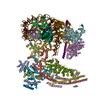
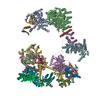
 PDBj
PDBj
